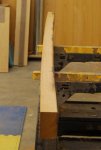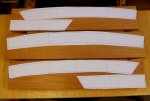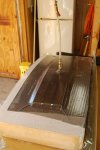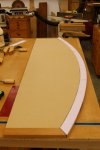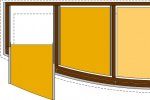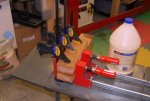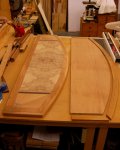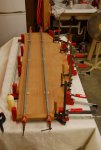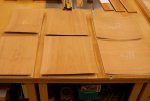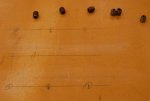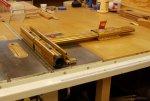... I am so uncomfortable working with veneers. I did one project and didnt have the greatest results, but I dont own a vacuum press, and I dont know what a good quality veneer is supposed to feel or work with.
You seem to have it down to an exact science. I guess in time Ill have to break down and learn the process correctly.
A vacuum press is great, if you have one. I wanted one and had access to a pump that a friend was selling. I got the remainder of the parts from JoeWW and built the thing. I'm too cheap to order the "real" vacuum press vinyl, so I bought very heavy vinyl material at Walmart a few years ago. In fact, my first vacuum press bag was a shower curtain. The heavy material is much better for larger items, of course.
Everything I've done and will do on this project could be done without a vacuum press. For instance, for the top veneers I could have done the same prep as for bagging but, at the point where I spread glue on the substrate, I would have also spread glue on the back of the veneer. Let the glue dry until tacky, spread another coat on the substrate, align the veneer on the substrate and use a clothing iron to activate the bond between veneer and substrate. The same procedure could be used for all other veneered parts on this project.
The bentwood components could be done like they were for centuries: by steaming the wood and clamping it over a form. I choose to cut thin (1/8" thick) strips and create a lamination, but I still could have done that with clamps and a form. The advantage of a vacuum press is its even pressure and not having to chase anywhere from three to sixty clamps and get them equal.

As to the "exact science", I have a course of events to thank for the training I got on veneering. I was a project manager for a firm based in Florida starting in 1998. The privately-held company sold to an international firm in the Fall of 2000. They began layoffs immediately but I was assured I was safe. I was until several layoff rounds later when I was in one of the last groups. Our last day of work was 9/7/2001. Four days later, things went crazy on many levels. I had contacts all over the country but most of them were also looking for jobs. When my unemployment was about to run out nine months later, I saw a listing for a bench carpenter in a high-end cabinet shop. I went for an interview and was hired on the spot. I had already built some decent things, but working in the shop gave me lots of exposure to different processes as well as the opportunity to do a lot of veneering. So, we never know what might lead us in any given direction. In this case, a bad event led me to much more knowledge than I could have gotten in the same amount of time otherwise.
Sorry to get so wordy. We now return you to the program already in progress.




